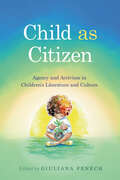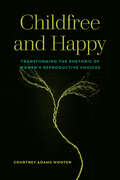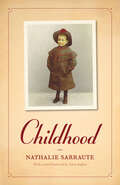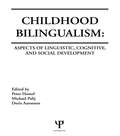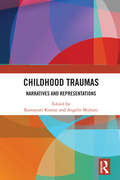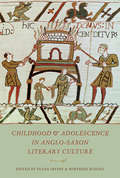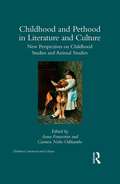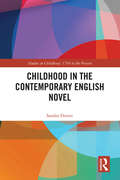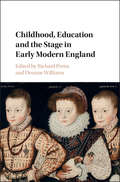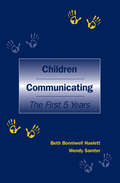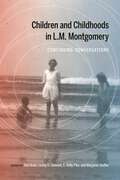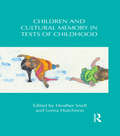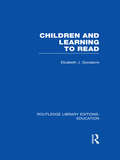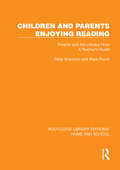- Table View
- List View
Child as Citizen: Agency and Activism in Children's Literature and Culture (Children's Literature Association Series)
by Giuliana FenechContributions by Daniela Brockdorff, Nina Christensen, Jill Coste, Katrin Dautel, Justyna Deszcz-Tryhubczak, Giuliana Fenech, Naomi Hamer, Irena Barbara Kalla, Anne Klomberg, Sonali Kulkarni, Elizabeth Leach-Leung, Ann Marie Murnaghan, Emily Murphy, Emilie Owens, Nicola Parker, Patrycja Poniatowska, Meg Rosoff, and Farriba SchulzChild as Citizen: Agency and Activism in Children’s Literature and Culture addresses children’s and young adult agency and activism across literature and culture, demonstrating how these forces influence child citizenship. Contributors to this volume highlight the agentic voices and activist practices that are growing across all spheres of young people’s lives, as well as the challenges to active citizenship that children growing up in unjust sociopolitical contexts face. The volume is interdisciplinary and draws on the sociology of childhood, children’s literature studies, youth culture studies, media, technology, and cultural studies, and Anthropocene, ecofeminist, and disability studies.Agency occurs in and around literature and storytelling, and this collection establishes how it is always influenced by identity as well as geopolitics; how it is both subjective and collective; how it is cultural and embodied; and how, like citizenship, it is not a static status but rather an ongoing negotiation. In this collection, contributors invite readers to consider agency as a system of relations between children themselves, between children and adults, children and institutions, and children and nation-states, as well as between children and the nonhuman. This book reviews the interconnectedness between these relationships and attempts to untangle some of the complications that emerge.
Child of the Dark (SparkNotes Literature Guide Series)
by SparkNotesChild of the Dark (SparkNotes Literature Guide) by Carolina Maria de Jesus Making the reading experience fun! Created by Harvard students for students everywhere, SparkNotes is a new breed of study guide: smarter, better, faster.Geared to what today's students need to know, SparkNotes provides:chapter-by-chapter analysis explanations of key themes, motifs, and symbols a review quiz and essay topicsLively and accessible, these guides are perfect for late-night studying and writing papers.
Childfree and Happy: Transforming the Rhetoric of Women's Reproductive Choices
by Courtney Adams WootenChildfree and Happy examines how millennia of reproductive beliefs (or doxa) have positioned women who choose not to have children as deviant or outside the norm. Considering affect and emotion alongside the lived experiences of women who have chosen not to have children, Courtney Adams Wooten offers a new theoretical lens to feminist rhetorical scholars’ examinations of reproductive rhetorics and how they circulate through women’s lives by paying attention not just to spoken or written beliefs but also to affectual circulations of reproductive doxa. Through interviews with thirty-four childfree women and analysis of childfree rhetorics circulating in historical and contemporary texts and events, this book demonstrates how childfree women individually and collectively try to speak back to common beliefs about their reproductive experiences, even as they struggle to make their identities legible in a sociocultural context that centers motherhood. Childfree and Happy theorizes how affect and rhetoric work together to circulate reproductive doxa by using Sara Ahmed’s theories of gendered happiness scripts to analyze what reproductive doxa is embedded in those scripts and how they influence rhetoric by, about, and around childfree women. Delving into how childfree women position their decision not to have children and the different types of interactions they have with others about this choice, including family members, friends, colleagues, and medical professionals, Childfree and Happy also explores how communities that make space for alternative happiness scripts form between childfree women and those who support them. It will be of interest to scholars in the fields of the rhetoric of motherhood/mothering, as well as feminist rhetorical studies.
Childhood
by Nathalie SarrauteAs one of the leading proponents of the "nouveau roman," Nathalie Sarraute is often remembered for her novels, including "The Golden Fruits," which earned her the Prix international de litterature in 1964. But her carefully crafted and evocative memoir "Childhood" may in fact be SarrauteOCOs most accessible and emotionally open work. Written when the author was eighty-three years old, but dealing with only the first twelve years of her life, "Childhood" is constructed as a dialogue between Sarraute and her memory. Sarraute gently interrogates her interlocutor in search of her own intentions, more precise accuracy, and indeed, the truth. Her relationships with her mother in Russia and her stepmother in Paris are especially heartbreaking: long-gone actions are prodded and poked at by Sarraute until they yield some semblance of fact, imbuing these maternalistic interactions with new, deeper meaning. Each vignette is bristling with detail and shows the power of memory through prose by turns funny, sad, and poetic. Capturing the ambience of Paris and Russia in the earliest part of the twentieth century, while never giving up the lyrical style of SarrauteOCOs novels, this book has much to offer both memoir enthusiasts and fiction lovers. "
Childhood Bilingualism: Aspects of Linguistic, Cognitive, and Social Development
by Doris Aaronson Peter Homel Michael PalijFirst published in 1987. This volume is based primarily on a conference on childhood bilingualism held at New York University on June 25 and 26, 1982 with an interest in exploring the nature of bilingual cognition and the effect of bilingualism on psychological development.
Childhood Traumas: Narratives and Representations
by Kamayani Kumar; Angelie MultaniThis volume contributes to understanding childhoods in the twentieth and twenty-firstcentury by offering an in-depth overview of children and their engagement with the violent world around them. The chapters deal with different historical, spatial, and cultural contexts, yet converge on the question of how children relate to physiological and psychological violence. The twentieth century has been hailed as the "century of the child" but it has also witnessed an unprecedented escalation of cultural trauma experienced by children during the two World Wars, Holocaust, Partition of the Indian subcontinent, and Vietnam War. The essays in this volume focus on victimized childhood during instances of war, ethnic violence, migration under compulsion, rape, and provide insights into how a child negotiates with abstract notions of nation, ethnicity, belonging, identity, and religion. They use an array of literary and cinematic representations—fiction, paintings, films, and popular culture—to explore the long-term effect of violence and neglect on children. As such, they lend voice to children whose experiences of abuse have been multifaceted, ranging from genocide, conflict and xenophobia to sexual abuse, and also consider ways of healing. With contributions from across the world, this comprehensive book will be useful to scholars and researchers of cultural studies, literature, education, education policy, gender studies, child psychology, sociology, political studies, childhood studies, and those studying trauma, conflict, and resilience.
Childhood and Adolescence in Anglo-Saxon Literary Culture (Toronto Anglo-Saxon Series)
by Susan Irvine Winfried RudolfChildhood and Adolescence in Anglo-Saxon Literary Culture counters the generally received wisdom that early medieval childhood and adolescence were an unremittingly bleak experience. The contributors analyse representations of children and their education in Old English, Old Norse and Anglo-Latin writings, including hagiography, heroic poetry, riddles, legal documents, philosophical prose and elegies. Within and across these linguistic and generic boundaries some key themes emerge: the habits and expectations of name-giving, expressions of childhood nostalgia, the role of uneducated parents, and the religious zeal and rebelliousness of youth. After decades of study dominated by adult gender studies, Childhood and Adolescence in Anglo-Saxon Literary Culture rebalances our understanding of family life in the Anglo-Saxon era by reconstructing the lives of medieval children and adolescents through their literary representation.
Childhood and Children's Books in Early Modern Europe, 1550-1800: Childhood And Children's Books In Early Modern Europe, 1550-1800 (Children's Literature and Culture #38)
by Andrea Immel Michael WitmoreFirst Published in 2006. Routledge is an imprint of Taylor & Francis, an informa company.
Childhood and Pethood in Literature and Culture: New Perspectives in Childhood Studies and Animal Studies (Children's Literature and Culture)
by Anna Feuerstein Carmen Nolte-OdhiamboBringing together new perspectives in childhood studies and animal studies, this book is the first collection to critically address the manifold alignments and frequent co-constitutions of children and pets in our families, our cultures, and our societies. The cultural politics of power shaping relationships between children, pets, and adults inform the wide range of essays included in this collection, as they explore issues such as protection, discipline, mastery, wildness, play, and domestication. The volume use the frequent social and cultural intersections between children and pets as an opportunity to analyze institutions that create pet and child subjectivity, from education and training to putting children and pets on display for entertainment purposes. Essays analyze legal discourses, visual culture, literature for children and adults, migration narratives, magazines for children, music, and language socialization to discuss how notions of nationalism, race, gender, heteronormativity, and speciesism shape cultural constructions of children and pets. Examining childhood and pethood in America, Europe, Asia, and the Pacific, this collection shows how discourses linking children and pets are pervasive and work across cultures. By presenting innovative approaches to the child and the pet, the book brings to light alternative paths toward understanding these figures, leading to new openings and questions about kinship, agency, and the power of care that so often shapes our relationships with children and animals. This will be an important volume for scholars of animal studies, childhood studies, children’s literature, cultural studies, political theory, education, art history, and sociology.
Childhood as Memory, Myth and Metaphor: Proust, Beckett, and Bourgeois
by Catherine Crimp"A fascination with childhood unites the artist Louise Bourgeois (1911-2010) and the writers Samuel Beckett (1906-89) and Marcel Proust (1871-1922). But while many commentators have traced their childhood images back to memories of lived experiences, there is more to their mythologies of childhood that waits to be explored. They invite us to move away from familiar ideas - whether psychological or biographical - about what a child can represent, and even what a child is. The haunting child figures of Bourgeois, Beckett and Proust echo each other as they show how imagining origins- for a life, for a work of art - involves paradoxes that test the limits of our forms of expression. Art meets literature, profusion meets concision, French meets English, and images of childhood reveal new insights in this encounter between three great figures of twentieth- and twenty-first-century culture. Catherine Crimp holds a PhD from the University of Cambridge and is currently Lectrice d'anglais at theEcole Normale Superieure de Lyon."
Childhood in Contemporary Diasporic African Literature: Memories and Futures Past (African Histories and Modernities)
by Christopher E. OumaThis book examines the representation of figures, memories and images of childhood in selected contemporary diasporic African fiction by Adichie, Abani, Wainaina and Oyeyemi. The book argues that childhood is a key framework for thinking about contemporary African and African Diasporic identities. It argues that through the privileging of childhood memory, alternative conceptions of time emerge in this literature, and which allow African writers to re-imagine what family, ethnicity, nation means within the new spaces of diaspora that a majority of them occupy. The book therefore looks at the connections between childhood, space, time and memory, childhood gender and sexuality, childhoods in contexts of war, as well as migrant childhoods. These dimensions of childhood particularly relate to the return of the memory of Biafra, the figures of child soldiers, memories of growing up in Cold War Africa, queer boyhoods/sonhood as well as experiences of migration within Africa, North America and Europe.
Childhood in the Contemporary English Novel (Studies in Childhood, 1700 to the Present)
by Sandra DinterSince the 1980s novels about childhood for adults have been a booming genre within the contemporary British literary market. Childhood in the Contemporary English Novel offers the first comprehensive study of this literary trend. Assembling analyses of key works by Ian McEwan, Doris Lessing, P. D. James, Nick Hornby, Sarah Moss and Stephen Kelman and situating them in their cultural and political contexts, Sandra Dinter uncovers both the reasons for the current popularity of such fiction and the theoretical shift that distinguishes it from earlier literary epochs. The book’s central argument is that the contemporary English novel draws on the constructivist paradigm shift that revolutionised the academic study of childhood several decades ago. Contemporary works of fiction, Dinter argues, depart from the notion of childhood as a naturally given phase of life and examine the agents, interests and conflicts involved in its cultural production. Dinter also considers the limits of this new theoretical impetus, observing that authors and scholars alike, even when they claim to conceive of childhood as a construct, do not always give up on the idea of its ‘natural’ core. Accordingly, this book reconstructs how the English novel between the 1980s and the 2010s oscillates between an acknowledgment of constructivism and an endorsement of childhood as the last irrevocable quintessence of humanity. In doing so, it successfully extends the literary and cultural history of childhood to the immediate present.
Childhood's End (SparkNotes Literature Guide Series)
by SparkNotesChildhood's End (SparkNotes Literature Guide) by Arthur Clarke Making the reading experience fun! Created by Harvard students for students everywhere, SparkNotes is a new breed of study guide: smarter, better, faster.Geared to what today's students need to know, SparkNotes provides:chapter-by-chapter analysis explanations of key themes, motifs, and symbols a review quiz and essay topicsLively and accessible, these guides are perfect for late-night studying and writing papers.
Childhood, Education and the Stage in Early Modern England
by Richard Preiss Deanne WilliamsWhat did childhood mean in early modern England? To answer this question, this book examines two key contemporary institutions: the school and the stage. The rise of grammar schools and universities, and of the professional stage featuring boy actors, reflect the culture's massive investment in children. In this collection, an international group of well-respected scholars examines how the representation of children by major playwrights and poets reflected the period's educational and cultural values. This book contains chapters that range from Shakespeare and Ben Jonson to the contemporary plays of Tom Stoppard, and that explore childhood in relation to classical humanism, medicine, art, and psychology, revealing how early modern performance and educational practices produced attitudes to childhood that still resonate to this day.
Childly Language: Children, language and the social world (Real Language Series)
by Alison SealeyChildly Language explores how attitudes and cultural assumptions about children and childhood are revealed in contemporary English. It addresses such questions as: How is concern for children's safety and welfare reflected in the vocabulary and grammar of contemporary English? and When we say that an adult is being 'childish', what are we saying about the characteristics of children?
Children Communicating: The First 5 Years (Routledge Communication Ser.)
by Wendy Samter Beth Bonniwell HaslettOffering a unique focus on the development of human communication, this book integrates and synthesizes a more comprehensive array of research than most investigations of communicative development. As such, it incorporates materials dealing with the development of nonverbal communication, language, and cognition, and examines how they are integrated in the growing child's everyday interaction. This information is distilled into a set of key principles and practices--culled from a variety of fields including developmental and social psychology, sociolinguistics, psycholinguistics, and communication--for parents or adults interested in child development. While this book does not offer an in-depth view in any one area, it provides a comprehensive overview of the various components of human communicative development and its significance for the child's cognitive and emotional growth. It is quite clear that developmental processes are constrained by multiple influences whose interactions have just begun to be uncovered. Examining the diverse facets of communicative development will enable professionals to garner further insights into the mystery of human communication.
Children Learning Second Languages
by Annamaria PinterChildren Learning Second Languages is a four-partcomprehensive guide to current research and debate related to second language learning in childhood, the age factor and the relationship between research and classroom practice. Part 1 covers child development, L1 and L2 language learning processes in childhood and offers a guide to contexts from foreign language learning at school to immersion education and bilingual/trilingual acquisition at home. Part 2 gives a bird's eye view of current research in the area of child SLA and pedagogy highlighting the strengths and weaknesses of different traditions and types of research. This is followed by a close examination of eight case studies. Part 3 is devoted to issues of future research priorities by discussing methodological and ethical difficulties in child focused research and outlining 15 feasible studies for the future. Part 4 offers some resources including hands-on teaching materials, handbooks, theoretical books, details of organizations and projects in the broad area of child second language learning. "
Children Tell Stories: Teaching and Using Storytelling in the Classroom
by Mitch Weiss Martha Hamilton Dede HatchThe revised edition of this award-winning guidebook on storytelling in the classroom includes over 80% new material. The authors provide compelling rationales for the value of storytelling, links to state literacy learning standards, detailed storytelling unit tips, easy ideas for storytelling throughout the curriculum, and carefully selected and extensive bibliographies. Considered the classic in the field, Children Tell Stories is useful to both experienced and novice teachers and storytellers who work with students from preschool through college.
Children Writing Poems: Poetic Voices in and out of School (Routledge Research in Education #12)
by Janine CertoThis volume demonstrates how the social and instructional worlds that children inhabit influence their poetry writing and performances. Drawing on rich vignettes of students from different racial, ethnic and linguistic backgrounds, it describes and analyzes the work of eight to ten-year-old U.S. students involved in a month-long poetry unit. Children Writing Poems outlines the value of a ‘poetic-functional’ approach to help children convey a poem’s meaning and mood, and expresses the need for educators to scaffold children’s oral readings and performances over time.
Children and Childhoods in L.M. Montgomery: Continuing Conversations
by Rita Bode, Lesley D. Clement, E. Holly Pike and Margaret StefflerFrom Jane Austen to contemporary fanfiction and adaptations, literary portrayals of the child and imaginings of childhood are particularly telling indicators of cultural values and when they shift. Inspired by the responsive reading practices of L.M. Montgomery herself, those demonstrated by her characters, and those of her diverse readership, Children and Childhoods in L.M. Montgomery works with concepts of confluence, based on organic, non-linear readings of texts across time and space. Such readings reconsider views of childhood and children by challenging power hierarchies and inequities found in approaches that privilege more linear readings of literary influence. While acknowledging differences between childhood and adulthood, contributors emphasize kinship between child and adult as well as between past and present selves and use both scholarly approaches and creative reimagining to explore how the boundaries between different stages of life are blurred in Montgomery’s writing. Children and Childhoods in L.M. Montgomery addresses Montgomery’s challenges to prescribed assumptions about childhood while positioning her novels as essential texts in twenty-first-century literary, childhood, and youth studies. Contributors include Yoshiko Akamatsu (Notre Dame Seishin University), Balaka Basu (UNC Charlotte), Rita Bode (Trent University), Holly Cinnamon, Lesley D. Clement, Vappu Kannas, Heidi Lawrence (University of Glasgow), Kit Pearson, Rosalee Peppard Lockyer, E. Holly Pike, Laura Robinson (Acadia University), Kate Scarth (UPEI), Margaret Steffler (Trent University), William Thompson (MacEwan University), Bonnie Tulloch (UBC), Asa Warnqvist (Swedish Institute for Children’s Books)
Children and Cultural Memory in Texts of Childhood: Children And Cultural Memory In Texts Of Childhood (Children's Literature and Culture)
by Heather Snell Lorna HutchisonThe essays in this collection address the relationship between children and cultural memory in texts both for and about young people. The collection overall is concerned with how cultural memory is shaped, contested, forgotten, recovered, and (re)circulated, sometimes in opposition to dominant national narratives, and often for the benefit of young readers who are assumed not to possess any prior cultural memory. From the innovative development of school libraries in the 1920s to the role of utopianism in fixing cultural memory for teen readers, it provides a critical look into children and ideologies of childhood as they are represented in a broad spectrum of texts, including film, poetry, literature, and architecture from Canada, the United States, Japan, Germany, Britain, India, and Spain. These cultural forms collaborate to shape ideas and values, in turn contributing to dominant discourses about national and global citizenship. The essays included in the collection imply that childhood is an oft-imagined idealist construction based in large part on participation, identity, and perception; childhood is invisible and tangible, exciting and intriguing, and at times elusive even as cultural and literary artifacts recreate it. Children and Cultural Memory in Texts of Childhood is a valuable resource for scholars of children’s literature and culture, readers interested in childhood and ideology, and those working in the fields of diaspora and postcolonial studies.
Children and Learning to Read (Routledge Library Editions: Education)
by Elizabeth GoodacreThis is a study of the nature of the process whereby children go about the business of learning to read. The author relates her own practical teaching experience closely to studies in developmental psychology, and also considers the special needs of individual children. In all, the book provides an invaluable contribution to our understanding of the processes involved in learning to read, and it should be of interest not only to teachers, but also to parents of young children.
Children and Parents Enjoying Reading: Parents and the Literacy Hour: A Teacher's Guide (Routledge Library Editions: Home and School)
by Peter Branston Mark ProvisWith the introduction of the Literacy Hour in 1998, the case for harnessing parental involvement in promoting children’s literacy was stronger than ever. Originally published in 1999, this book offered a detailed and practical approach, based on three key concepts: keeping the child in the driving seat, continuing support from the school to the parents and daily reading at home. It is presented in an accessible manner and offers practical advice to teachers in running and evaluating a scheme. It also gives parents a chance to think about the nature of their involvement at word, sentence and text levels, introducing them to the framework of the National Literacy Strategy.Good reading skills are essential for access to the wider curriculum, yet above all, reading is fun. This book helped teachers, parents and children to work together to make reading at home more enjoyable. It was also to help ensure that children achieved the standards of literacy expected for their age by 2002. Today it can still be used to help children learn to read.
Children and Television: Fifty Years of Research (Routledge Communication Series)
by Norma Pecora John P. Murray Ellen Ann WartellaThis seminal volume is a comprehensive review of the literature on children's television, covering fifty years of academic research on children and television. The work includes studies of content, effects, and policy, and offers research conducted by social scientists and cultural studies scholars. The research questions represented here consider the content of programming, children's responses to television, regulation concerning children's television policies, issues of advertising, and concerns about sex and race stereotyping, often voicing concerns that children's entertainment be held to a higher standard. The volume also offers essays by scholars who have been seeking answers to some of the most critical questions addressed by this research. It represents the interdisciplinary nature of research on children and television, and draws on many academic traditions, including communication studies, psychology, sociology, education, economics, and medicine. The full bibliography is included on CD.Arguably the most comprehensive bibliography of research on children and television, this work illustrates the ongoing evolution of scholarship in this area, and establishes how it informs or changes public policy, as well as defining its role in shaping a future agenda. The volume will be a required resource for scholars, researchers, and policy makers concerned with issues of children and television, media policy, media literacy and education, and family studies.
Children and Their Changing Media Environment: A European Comparative Study (Routledge Communication Series)
by Sonia Livingstone Moira BovillFocusing on the meanings, uses, and impacts of new media in childhood, family life, peer culture, and the relation between home and school, this volume sets out to address many of the questions, fears, and hopes regarding the changing place of media in the lives of today's children and young people. The scholars contributing to this work argue that such questions--intellectual, empirical, and policy-related--can be productively addressed through cross-national research. Hence, this volume brings together researchers from 12 countries--Belgium, Denmark, Finland, France, Germany, the United Kingdom, Israel, Italy, the Netherlands, Spain, Sweden, and Switzerland--to present original and comprehensive findings regarding the diffusion and significance of new media and information technologies among children. Inspired by parallels and difference between the arrival of television in the family home during the 1950s and the present day arrival of new media, the research is based on in-depth interviews and a detailed comparative survey of 6- to 16-year-olds across Europe and in Israel. The result is a comprehensive, detailed, and fascinating account of how these technologies are rapidly becoming central to the daily lives of young people. As a resource for researchers and students in media and communication studies, leisure and cultural studies, social psychology, and related areas, this volume provides crucial insights into the role of media in the lives of children. The findings included herein will also be of interest to policymakers in broadcasting, technology, and education throughout the world.
